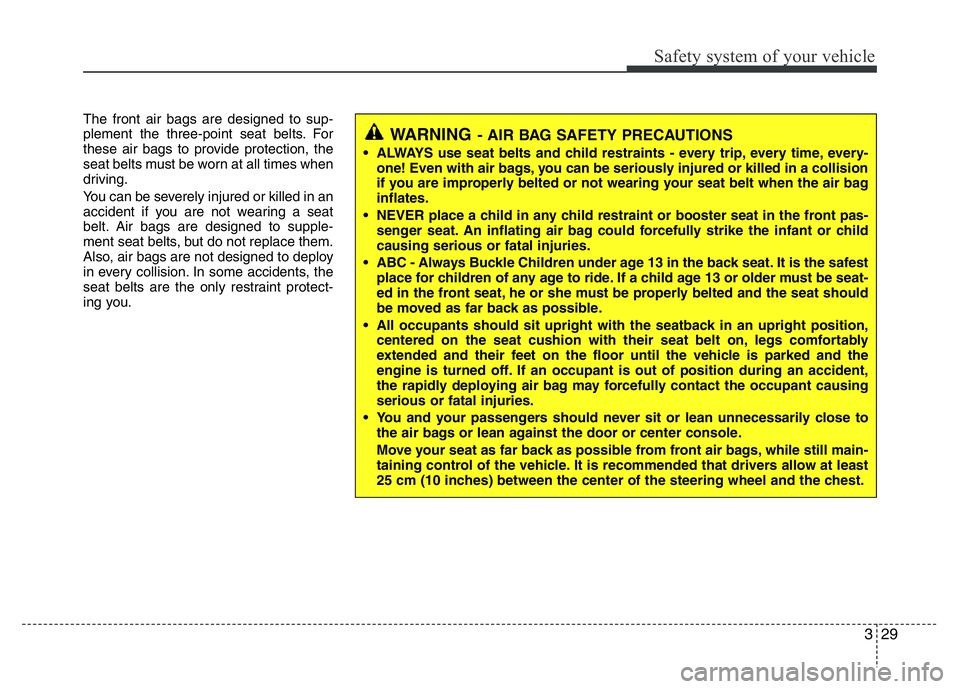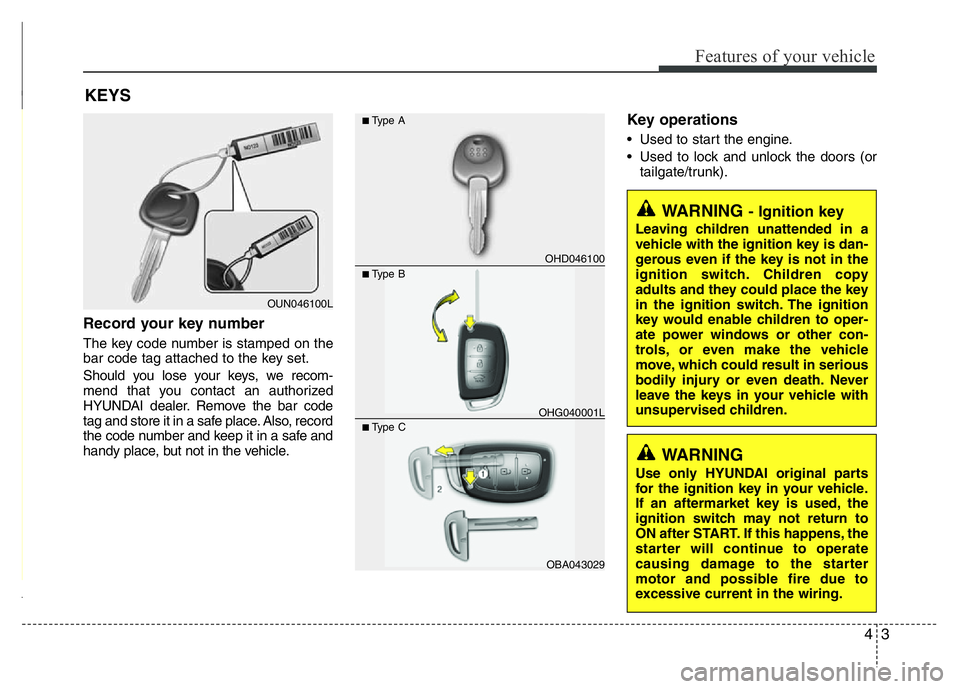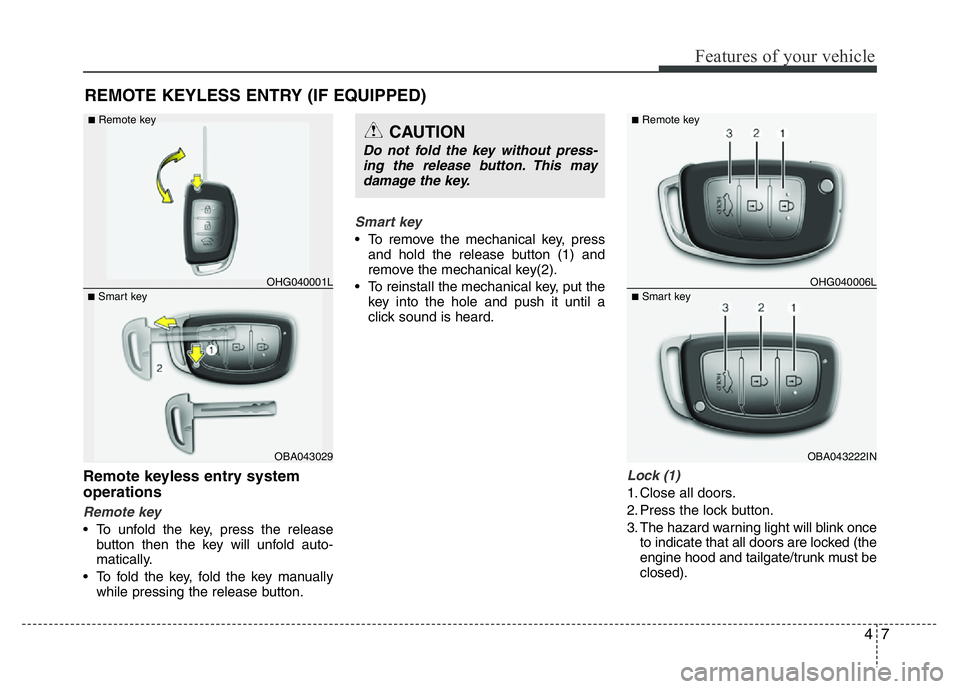2018 HYUNDAI I10 engine
[x] Cancel search: enginePage 45 of 343

329
Safety system of your vehicle
The front air bags are designed to sup-
plement the three-point seat belts. For
these air bags to provide protection, the
seat belts must be worn at all times when
driving.
You can be severely injured or killed in an
accident if you are not wearing a seat
belt. Air bags are designed to supple-
ment seat belts, but do not replace them.
Also, air bags are not designed to deploy
in every collision. In some accidents, the
seat belts are the only restraint protect-
ing you.
WARNING- AIR BAG SAFETY PRECAUTIONS
• ALWAYS use seat belts and child restraints - every trip, every time, every-
one! Even with air bags, you can be seriously injured or killed in a collision
if you are improperly belted or not wearing your seat belt when the air bag
inflates.
• NEVER place a child in any child restraint or booster seat in the front pas-
senger seat. An inflating air bag could forcefully strike the infant or child
causing serious or fatal injuries.
• ABC - Always Buckle Children under age 13 in the back seat. It is the safest
place for children of any age to ride. If a child age 13 or older must be seat-
ed in the front seat, he or she must be properly belted and the seat should
be moved as far back as possible.
• All occupants should sit upright with the seatback in an upright position,
centered on the seat cushion with their seat belt on, legs comfortably
extended and their feet on the floor until the vehicle is parked and the
engine is turned off. If an occupant is out of position during an accident,
the rapidly deploying air bag may forcefully contact the occupant causing
serious or fatal injuries.
• You and your passengers should never sit or lean unnecessarily close to
the air bags or lean against the door or center console.
Move your seat as far back as possible from front air bags, while still main-
taining control of the vehicle. It is recommended that drivers allow at least
25 cm (10 inches) between the center of the steering wheel and the chest.
Page 48 of 343

Safety system of your vehicle
32 3
SRS warning light
The SRS (Supplement Restraint System)
air bag warning light on the instrument
panel displays the air bag symbol depicted
in the illustration. The system checks the
air bag electrical system for malfunctions.
The light indicates that there is a potential
problem with your air bag system.During a moderate to severe frontal colli-
sion, sensors will detect the vehicle’s
rapid deceleration. If the rate of deceler-
ation is high enough, the control unit will
inflate the front air bags.
The front air bags help protect the driver
and front passenger by responding to
frontal impacts in which seat belts alone
cannot provide adequate restraint. When
needed, the side air bags help provide
protection in the event of a side impact or
rollover by supporting the side upper
body area.
• Air bags are activated (able to inflate if
necessary) only when the ignition
switch is in the ON position.
• Air bags inflate in the event of a severe
frontal or side collision to help protect
the occupants from serious physical
injury.
• There is no single speed at which the
air bags will inflate. Generally, air bags
are designed to inflate based upon the
severity of a collision and its direction.
These two factors determine whether
the sensors produce an electronic
deployment/inflation signal.
WARNING
If your SRS malfunctions, the air bag
may not inflate properly during an
accident increasing the risk of seri-
ous injury or death.
If any of the following conditions
occur, your SRS is malfunctioning:
• The light does not turn on for
approximately six seconds when
the ignition switch is placed in
the ON position.
• The light stays on after illuminat-
ing for approximately six sec-
onds.
• The light comes on while the
vehicle is in motion.
(Continued)
(Continued)
• The light blinks when the engine
is running.
We recommend that an authorized
HYUNDAI dealer inspect the SRS as
soon as possible if any of these
conditions occur.
Page 64 of 343

43
Features of your vehicle
Record your key number
The key code number is stamped on the
bar code tag attached to the key set.
Should you lose your keys, we recom-
mend that you contact an authorized
HYUNDAI dealer. Remove the bar code
tag and store it in a safe place. Also, record
the code number and keep it in a safe and
handy place, but not in the vehicle.
Key operations
• Used to start the engine.
• Used to lock and unlock the doors (or
tailgate/trunk).
KEYS
WARNING - Ignition key
Leaving children unattended in a
vehicle with the ignition key is dan-
gerous even if the key is not in the
ignition switch. Children copy
adults and they could place the key
in the ignition switch. The ignition
key would enable children to oper-
ate power windows or other con-
trols, or even make the vehicle
move, which could result in serious
bodily injury or even death. Never
leave the keys in your vehicle with
unsupervised children.
OUN046100L
WARNING
Use only HYUNDAI original parts
for the ignition key in your vehicle.
If an aftermarket key is used, the
ignition switch may not return to
ON after START. If this happens, the
starter will continue to operate
causing damage to the starter
motor and possible fire due to
excessive current in the wiring.
OHD046100
■Type A
■Type B
OBA043029
■Type COHG040001L
Page 65 of 343

Features of your vehicle
4 4
Immobilizer system (if equipped)
■ Type A
Your vehicle may be equipped with an
electronic engine immobilizer system to
reduce the risk of unauthorized vehicle
use.
Your immobilizer system is comprised of
a small transponder in the ignition key
and electronic devices inside the vehicle.
With the immobilizer system, whenever
you insert your ignition key into the igni-
tion switch and turn it to ON, it checks
and determines and verifies if the ignition
key is valid or not.
If the key is determined to be valid, the
engine will start.
If the key is determined to be invalid, the
engine will not start.
To deactivate the immobilizer system:
Insert the ignition key into the key cylin-
der and turn it to the ON position.
To activate the immobilizer system:
Turn the ignition key to the OFF position.
The immobilizer system activates auto-
matically. Without a valid ignition key for
your vehicle, the engine will not start.
✽NOTICE
When starting the engine, do not use the
key with other immobilizer keys around.
Otherwise the engine may not start or
may stop soon after it starts. Keep each
key separate in order to avoid a starting
malfunction.
✽NOTICE
If you need additional keys or lose your
keys, we recommend that you consult an
authorized HYUNDAI dealer.
OHD046100
CAUTION
Do not put metal accessories near
the ignition switch.
Metal accessories may interrupt the
transponder signal and may pre-
vent the engine from starting.
WARNING
In order to prevent theft of your vehi-
cle, do not leave spare keys any-
where in your vehicle. Your immobi-
lizer password is a customer unique
password and should be kept confi-
dential. Do not leave this number
anywhere in your vehicle.
Page 66 of 343

45
Features of your vehicle
■ Type B
Your vehicle is equipped with an electron-
ic engine immobilizer system to reduce
the risk of unauthorized vehicle use.
Your immobilizer system is comprised of
a small transponder in the smart key and
electronic devices inside the vehicle.
With the immobilizer system, whenever
you turn the engine start/stop button to
the ON position by pressing the button
while carrying the smart key, it checks
and determines and verifies if the smart
key is valid or not.
If the key is determined to be valid, the
engine will start.
If the key is determined to be invalid, the
engine will not start.
To deactivate the immobilizer sys-
tem:
Turn the engine start/stop button to the
ON position by pressing the button while
carrying the smart key.
To activate the immobilizer system:
Turn the engine start/stop button to the
OFF position. The immobilizer system
activates automatically. Without a valid
smart key for your vehicle, the engine will
not start.
CAUTION
The transponder in your ignition
key is an important part of the
immobilizer system. It is designed
to give years of trouble-free service,
however you should avoid expo-
sure to moisture, static electricity
and rough handling. Immobilizer
system malfunction could occur.
CAUTION
Do not change, alter or adjust the
immobilizer system because it
could cause the immobilizer sys-
tem to malfunction.We recommend
that the system be serviced by an
authorized HYUNDAI dealer.
Malfunctions caused by improper
alterations, adjustments or modifi-
cations to the immobilizer system
are not covered by your vehicle
manufacturer warranty.
WARNING
In order to prevent theft of your
vehicle, do not leave spare keys
anywhere in your vehicle. Your
Immobilizer password is a cus-
tomer unique password and should
be kept confidential. Do not leave
this number anywhere in your vehi-
cle.
Page 67 of 343

Features of your vehicle
6 4
✽NOTICE
When starting the engine, do not use the
key with other immobilizer keys around.
Otherwise the engine may not start or
may stop soon after it starts. Keep each
key separate in order to avoid a starting
malfunction.
✽NOTICE
If you need additional keys or lose your
keys, we recommend that you consult an
authorized HYUNDAI dealer.
CAUTION
The transponder in your smart key
is an important part of the immobi-
lizer system. It is designed to give
years of trouble-free service, how-
ever you should avoid exposure to
moisture, static electricity and
rough handling. Immobilizer sys-
tem malfunction could occur.
CAUTION
Do not change, alter or adjust the
immobilizer system because it
could cause the immobilizer sys-
tem to malfunction. We recommend
that the system be serviced by an
authorized HYUNDAI dealer.
Malfunctions caused by improper
alterations, adjustments or modifi-
cations to the immobilizer system
are not covered by your vehicle
manufacturer warranty.
CAUTION
Do not put metal accessories near
the smart key.
The engine may not start because
the metal accessories may interrupt
the transponder signal from trans-
mitting normally.
Page 68 of 343

47
Features of your vehicle
Remote keyless entry system
operations
Remote key
• To unfold the key, press the release
button then the key will unfold auto-
matically.
• To fold the key, fold the key manually
while pressing the release button.
Smart key
• To remove the mechanical key, press
and hold the release button (1) and
remove the mechanical key(2).
• To reinstall the mechanical key, put the
key into the hole and push it until a
click sound is heard.
Lock (1)
1. Close all doors.
2. Press the lock button.
3. The hazard warning light will blink once
to indicate that all doors are locked (the
engine hood and tailgate/trunk must be
closed).
REMOTE KEYLESS ENTRY (IF EQUIPPED)
OBA043029
■Smart keyOHG040001L
■Remote keyCAUTION
Do not fold the key without press-
ing the release button. This may
damage the key.
OBA043222IN
■Smart keyOHG040006L
■Remote key
Page 72 of 343

411
Features of your vehicle
Smart key function
1. Door lock
2. Door unlock
3. Tailgate/trunk unlock
With a smart key, you can lock or unlock
a door and tailgate/trunk and even start
the engine without inserting the key.
The functions of the buttons on a smart
key are similar to the remote keyless
entry. Refer to the “Remote keyless
entry” in this section.Carrying the smart key, you may lock and
unlock the vehicle doors and tailgate/trunk.
Also, you may start the engine. Refer to
the following, for more details.
Locking
1. Carry the smart key.
2. Close all doors.
3. Press the button of the outside door
handle.
4. The hazard warning lights will blink
once (the engine hood and tailgate/trunk
must be closed).
5. Make sure that doors are locked by
pulling the outside door handle.
✽NOTICE
• The button will only operate when the
smart key is within 0.7 m (28 in.) from
the outside door handle.
• Even though you press the outside
door handle button, the doors will not
lock and the chime will sound for 3
seconds if any of following occur:
- The smart key is in the vehicle.
- The engine start/stop button is in
ACC or ON position.
- Any door except the tailgate/trunk is
opened.
SMART KEY (IF EQUIPPED)
OBA043222INOBA043010L